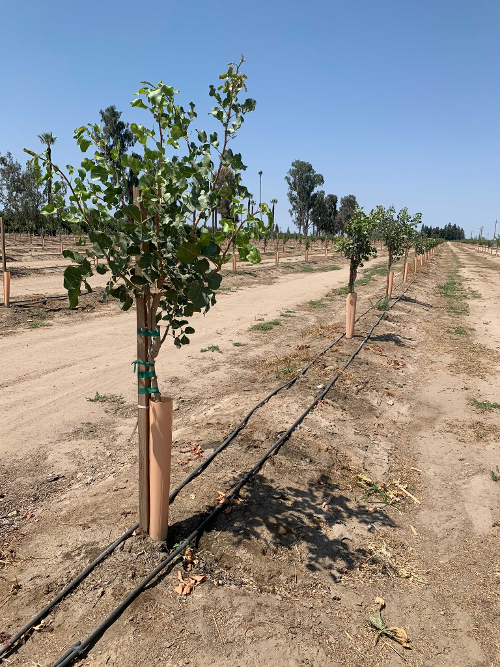Preventing Winter Juvenile Tree Dieback in Pistachios
No farmer’s cafe chat on planting a new pistachio orchard would be complete without mentioning the abnormally long period from planting to cropping. Given the investment needed to start turning a profit, losing trees to Winter Juvenile Tree Dieback (WJTD), is a pistachio farmer's worst nightmare. Fortunately, with the strategic application of water stress, it is possible to help reduce the chance of this happening.
A long journey to a harvestable pistachio crop
While most permanent crops will begin to produce a harvestable crop within three years, pistachios generally require six years before it is worth harvesting. Not only do pistachios grow at an agonizingly slow rate, the process of planting, pruning, grafting, and many more rounds of extensive pruning only slow the process more.
The end of the first year yields a plant only a couple of feet tall and with only a couple hundred leaves at the most. Six years of even aggressive growth yields a modest tree that is maybe eight feet tall and a canopy with less than a six-foot radius.

Example of a young pistachio orchard
With all the time and labor involved in establishing an orchard, it is especially devastating to have up to 20% of a young orchard wake from dormancy damaged, or never wake at all, due to WJTD. While all the potential contributors to WJTD are still being studied, there is a definite relationship between the small size of the trees and water stress.
How to help prevent Winter Juvenile Tree Dieback (WJTD)
Normally, I discuss ways to avoid water stress, but in the case of reducing the chance of WJTD, it is water stress that will save the trees.
WJTD is a condition that, depending on the severity, causes the dieback of the limbs and sometimes the scion or rootstock of juvenile pistachio trees. The resulting damage can set back the development of the tree by many years, or in the worst cases, kill it entirely. What makes WJTD unique is that it is an abiotic condition, meaning it is not caused by a disease or pest. Winter comes with a field of healthy young trees, but spring reveals dieback and loss.
Because pistachio trees are not native to the Western U.S., they don’t always pick up the normal environmental cues warning that winter is coming. During this time, if they are happily growing, they don’t always properly prepare for dormancy. Once winter and frost arrive, the tree takes damage that has the potential of setting it back years or killing it outright.
It is uncertain if older trees “learn” how to recognize the signs of oncoming winter, or if they are just more hearty than juvenile trees. Whatever the case, trees of the eighth leaf and younger are at the greatest risk of damage. In order to reduce the risk, we must help them prepare for winter by inducing stress that will help them go dormant. However, the tiny size of juvenile trees means that it takes much longer to turn the conditions from ideal for vigorous growth to a state that induces dormancy.
How to induce dormancy (via water stress) in juvenile pistachio trees
Evapotranspiration (Et) for a mature pistachio orchard maxes out between 2.41 and 2.76” per week, but a first leaf pistachio only uses a tenth of that, at max. So, while a mature orchard can easily use up the water in the soil and begin to stress within a short time, it takes much longer for a juvenile tree to do the same. Mix into this the cooler weather and lower Et rates that occur late in the season, and it can take a very long time to dry the soil of an immature orchard out enough to induce stress and encourage dormancy.
Tracking the soil moisture via a sensor can give a good idea of where you stand; significant stress tends to begin underneath 20% available water content. However, with Et rates so slow, you have to begin early to make it happen.
Here are some rough rules of thumb for possible irrigation cut-off times:
- For trees third leaf and under: irrigation should be discontinued at the end of August. Irrigating after that point will lead to excess water, excess tree vigor, and delayed dormancy. August is often the hottest month of the season. It can feel like a betrayal to shut off the water so early, but it pays off in the long term when the babies you have spent so much time and money tending go fully dormant and are more fully protected from damaging frosts.
- For slightly older trees: they are better able to dry the soil in a shorter period, but you should still be planning to discontinue irrigation in September and only supplement with more water if the trees go into severe drought stress before the end of September.
“What doesn’t kill you makes you stronger,” is an adage no one is comfortable with, but trees know how to protect themselves from winter stress. We just have to help them get there a little sooner than they are programmed to behave and a little extra stress will only help them weather the winter.
This article is for informational purposes only. Please consult your PCA or Crop Advisor for advice.



